Water hammer in the water supply and heating system: causes + preventive measures
One of the main problems when operating autonomous heating and water supply systems is pressure drop.Water hammer in the water supply and water heating system resulting from this sudden change can cause serious damage. He needs to be warned, don't you agree?
We will tell you how to prevent the phenomenon and neutralize its negative consequences, ensuring uninterrupted operation of the circuits. Here you will learn what methods are used to eliminate water hammer in systems that transport water to water taps and heating devices.
The article presented for review examines in detail the nature of water hammer. Preventive measures are listed to prevent the occurrence of a dangerous situation. For a visual understanding of this difficult topic, diagrams, photo illustrations and videos are attached.
The content of the article:
What is water hammer?
Water hammer is a short-term but significant surge in pressure in a fluid-filled system. This phenomenon occurs when a fluid flow collides with an obstacle that appears in its path. Typical examples of the occurrence of such obstacles include sudden closure of shut-off valves, sudden stop of the pump, air lock, etc.
Having encountered an obstacle, the flow of water by inertia continues to flow at the speed at which it was moving before the obstacle appeared.The first layers in contact with the obstacle are compacted at the same speed due to the arrival of subsequent layers.
Due to the constant injection of new layers of flow, the pressure rapidly increases, and the liquid “looks” for a way to dump its part in order to discharge it.
A similar situation almost always occurs when the flow breaks ball valve or a valve. At first glance, the phenomenon may seem harmless. That’s why many owners don’t give it much attention.
But in fact, if the prerequisites for an impending defect in pipes and fittings are discovered, it is worth eliminating it as quickly as possible. After all, due to water hammer, splits and cracks appear in the heating system, as well as equipment damage.
This serious problem may be preceded by clicks and knocks, as well as extraneous noise in the water supply pipes, accompanied by a characteristic “growling”.
Clicking predominantly occurs in places where larger pipes are connected to smaller pipes. The water passing along their inner walls encounters an obstacle, albeit incomplete, but still an obstacle.
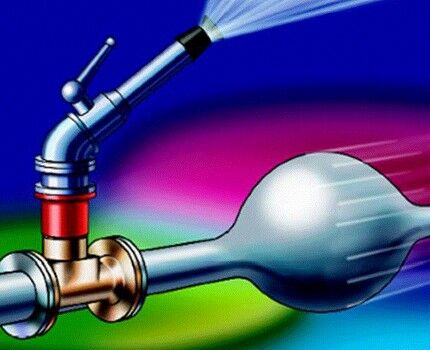
In the event of an emergency, the following may suffer from the water hammer effect:
- equipment (the tightness of pipelines is broken and heating devices are destroyed);
- property (water flowing from a damaged network will flood the home and lead to damage to furniture);
- household (if a violation occurs in the heating system, there is a danger of serious thermal burns).
According to statistics, the “lion's share” of pipeline failures, amounting to about 60%, occurs due to water hammer. More often, negative consequences from this effect can be observed in worn-out pipes covered with corrosion.
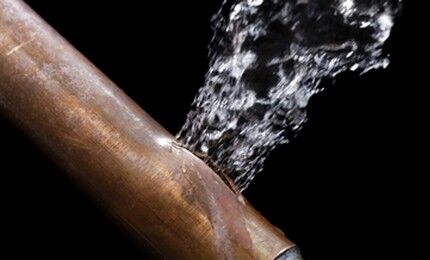
It causes the most trouble to long pipelines, for example, when installing "warm floor", along the contours of which a liquid heated to a certain temperature circulates.
The degree of damage largely depends on the location of the obstacle: if it is at the beginning of a long pipeline, the amount of increased pressure will be insignificant, but if at the end it will be much higher.
Most often, the effect occurs when pipes of different diameters were used when laying the heating system. If “different-sized” pipes are not brought to a common “denominator” using adapters, an increase in pressure in the heating system is inevitable. In this situation, to protect the system, the circuit is equipped with a special valve - a thermostat.
Causes of water hammer
The physical nature of this phenomenon lies in the complete loss or significant reduction in the throughput of water pipelines, as a result of which the fluid pressure in the system increases.
In houses where engineering communications were poorly designed and equipped, you can often hear characteristic tapping and clicking in the pipeline.
They are an external manifestation of water hammer and occur when fluid circulation in a closed system suddenly stops, and then its movement also suddenly resumes.
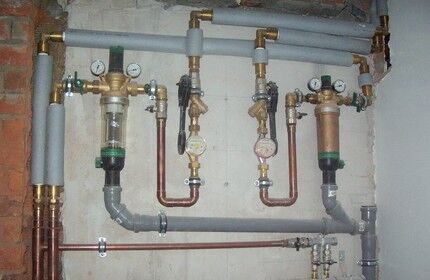
If an obstacle appears in the path of a flow of water moving at a certain speed, its speed of movement slows down, and the volume continues to increase. Finding no way out, it forms a reverse wave, which, colliding with the main body of water, increases the pressure in the system. Sometimes it can reach a threshold of 20 Atm.
Due to the tightness of the highway, the accumulated volume has nowhere to go, but powerful energy still strives to find an outlet into the external environment. The impact force resulting from such a collision creates the danger of rupture of the pipe, which does not have a sufficient margin of safety.
For this reason, to equip the system, it is necessary to use seamless water and gas pipes adapted for water networks that comply with GOST 3262-75, or pressure metal-plastic analogues manufactured in accordance with GOST 18599.

The main factors that provoke the occurrence of water hammer in pipes are:
- interruptions in operation or failure of the circulation pump;
- presence of air in a closed circuit of the system;
- power outages;
- in case of sudden closure of shut-off valves.
A short-term increase in pressure in a closed circuit due to fluid injection above the prescribed norm can occur if, when the pump is turned on, the impeller begins to move at high speeds.
Recently, during the arrangement autonomous heating system Instead of old valves and gate valves, ball valves are increasingly being used, the design of which does not provide for smooth operation.
Their ability to have a quick-acting effect has a downside, being one of the most common causes of water hammer.
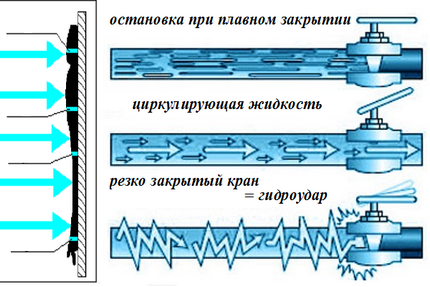
In terms of safety, screw valves are more preferable because, due to the gradual unwinding of the axleboxes, they ensure smooth opening/closing of the shut-off valves.
A similar situation occurs when air is not released from the circuit before starting the system. When the tap is opened, the water encounters an air plug, which, in a closed system, acts as a kind of pneumatic shock absorber.
How to avoid the problem?
Proper protection of the water supply pipeline system will help reduce the intensity and neutralize the influence of excess pressure.
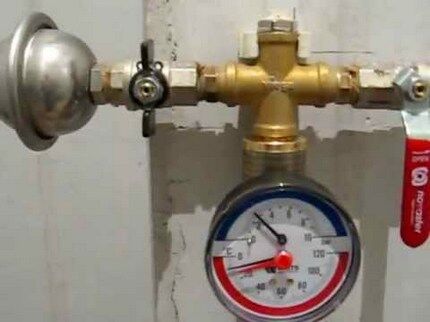
To prevent the creation of excess pressure of a one-time and permanent nature, both in a separate section of the circuit and in the entire system as a whole, a number of basic measures are used.
Option 1. Smooth system shutdown
This is one of the main requirements when starting up and shutting down pipeline systems, which is clearly stated in regulatory documents.
The fact is that the energy of the hydraulic shock, due to the elasticity of the pipe walls, does not act with all its force at the same time. Due to compensation of elastic deformations, it is divided into several time intervals.
Therefore, with the same total impact force, the impact power at a certain moment will be significantly reduced. By smoothly switching on, the process of pressure build-up can be extended over time, minimizing significant damage to the system.
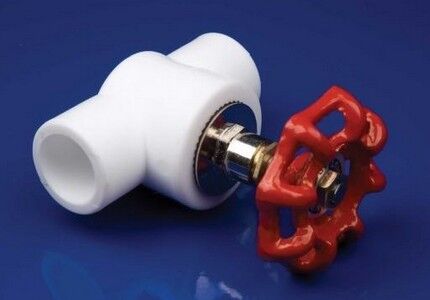
Taps, the design of which provides for a large gap until the water is turned off, are installed at the stage of equipment installation.
Option #2. Application of automatic devices
The automation must be configured to smoothly adjust the static pressure in the system. The installation of pumps with automatic speed control or electronically controlled units that are equipped with built-in frequency converters helps to achieve the desired effect.

Pumps equipped with automatic motor speed control are capable of smoothly increasing/decreasing pressure in the system. In this case, the software simultaneously performs two tasks: monitors changes in pressure in the water supply and automatically adjusts the pressure.
Methods for comprehensive system modernization
A comprehensive modernization of the system involves the installation of equipment aimed at neutralizing the effects of excess pressure.
Method #1. Application of compensators and shock absorbers
Dampeners and hydraulic accumulators simultaneously perform three functions: collect liquid, eliminating its excess volume from the system, and also help prevent unwanted phenomena.
A compensating device, the role of which is played by a hydraulic accumulator, is installed in the direction of water movement at those intervals of the heating circuit where there is a high probability of pressure fluctuations in the system.
A hydraulic accumulator or damper is a steel flask with a volume of up to 30 liters, including two sections separated by a rubber or rubber membrane.
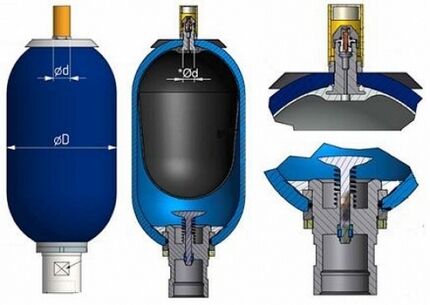
When pressure increases, hydraulic shocks are “dropped” into the reservoir. By bending the rubber membrane towards the air chamber at the moment the water column rises, the effect of artificially increasing the volume of the circuit is achieved.
Pipes made of heat-resistant reinforced rubber or elastic plastic are used as shock-absorbing devices.
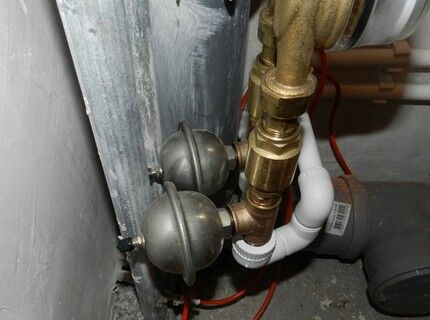
To achieve the desired effect, it is enough to use a product 20-30 cm long. If the pipeline is long, the shock absorber section is increased by another 10 cm.
Method #2.Installation of a diaphragm type safety valve
A diaphragm-type safety valve is placed on a pipe outlet near the pump to release a predetermined amount of water when there is excess pressure.
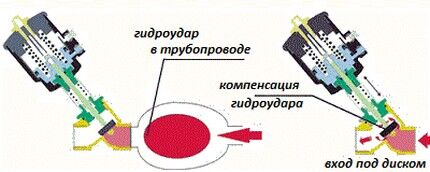
Depending on the manufacturer and model type, the safety valve is actuated either by an electrical command from the controller or by a quick-acting pilot device.
The device is triggered when the pressure exceeds a safe level, protecting pumping station when the equipment suddenly stops. At the moment of a dangerous surge in pressure, it opens completely, and when it drops to a normal level, the regulator slowly closes.
Method #3. Equipping a thermostatic valve with a shunt
The shunt is a narrow tube with a clearance of 0.2-0.4 mm, which is installed in the direction of coolant circulation. The main task of the element is to gradually lower pressure.
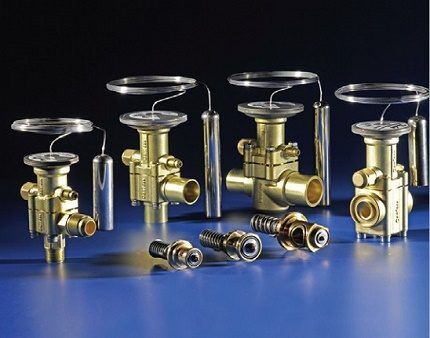
The bypass method is used when arrangement of autonomous systems, the pipeline of which is made only of new pipes. This is due to the fact that the presence of rust and sediment in old pipes can reduce the effectiveness of shunting to “no”. For this reason, when using a shunt at the inlet of the heating circuit, it is recommended to install efficient water filters.
Method #4. Using a Super Safety Thermostat
This is a kind of fuse that monitors the pressure in the system and does not allow it to work after the indicator reaches a critical level. The device is equipped with a spring mechanism located between the thermal head and the valve. The spring mechanism is triggered by excess pressure, preventing the valve from closing completely.
Such thermostats are installed strictly in the direction indicated on the housing.
Carrying out preventive work
In addition to strictly following the rules for operating pipelines, timely implementation of preventive measures helps prevent accidents. After all, all processes in the water supply system or heating circuit are interconnected. And the water hammer is only the final destructive “drop” that can lead to negative consequences against the background of the unsatisfactory technical condition of the water supply system.
Pipeline vibrations and pressure changes contribute to the formation of microcracks in the metal structure. Defects formed over time during the onset of water hammer immediately appear in areas of increased internal stress: mechanical joints, bends and welding seams.
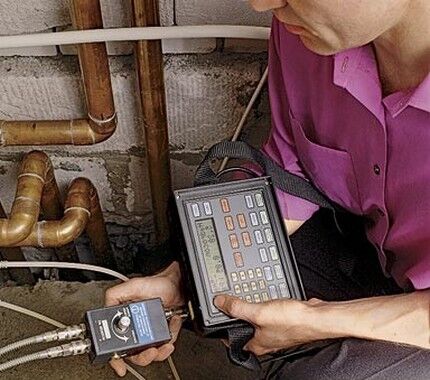
The main set of works performed during prevention:
- security group health check: safety valve, air vent and pressure gauge;
- periodically checking the pressure behind the expansion tank membrane, and if unsatisfactory results are detected, its adjustment;
- testing the system for leaks and checking the degree of pipe wear;
- valve position trackingshut-off and control valves for leaks;
- regularly checking the condition of filtersthat retain scale, sand and rust particles; if necessary, clean and rinse the elements;
Prevention aimed at maintaining the good condition of plumbing and heating system, includes simple types of work. But you shouldn't ignore them. After all, this can lead to significant waste of money and time for full-fledged repair work.
The listed protection measures are most effective if they are applied comprehensively. But thanks to an integrated approach to solving the problem, you will be able to neutralize the negative consequences and thereby extend the service life of the system.
Conclusions and useful video on the topic
Video #1. Water hammer, how it happens:
Video #2. Test of the effectiveness of the damper:
Water hammer in a water supply system is a common occurrence that can cause serious harm. And your task is to fix the problem as quickly as possible. After all, if the situation repeats, the elements of the system will soon fail. And repairs after that will cost much more.
Please ask questions and write comments in the block below. We are waiting for your stories about how you recorded a water hammer in the system or noticed its consequences. I'm interested in your opinion on the information presented.




Almost everyone has encountered a similar phenomenon. By the way, even in an apartment, when replacing the faucet gaskets and closing the main valve, you can make a water hammer. It is clear that its strength will not be very significant, but over time it will disable the water supply system.That is why it is recommended that in apartments and houses, after repair work, before opening the central valve, open the taps slightly so that the pressure surge is mitigated.
I have never encountered water hammer in the water supply system. Maybe because I live in an apartment - once only the pipes “hummed” and they were directly shaking, but there was no water hammer. There is somewhere in the water supply where the water will go. But in the cooling system of a car engine, the effect of water hammer had to be observed a couple of times - the effect, of course, is amazing. Even a small amount of water has a huge amount of energy.
Living in an apartment is not a guarantee that you will not experience water hammer. In our neighbor's apartment building, a heated towel rail burst due to the fault of the plumber of the management company.
The washing machine opens and closes the water using solenoid valves. After purchasing a new car, I began to notice knocks heard in all the pipes when the washing machine valve was activated. You can hear it throughout the house, and where the drinking water filter installation is located, the flexible plastic tubes with which it is connected are jumping and shaking at this moment.
Actually, that’s what I came for - I’m looking for some kind of damper, a simple shock absorber, to put in front of the washing machine.